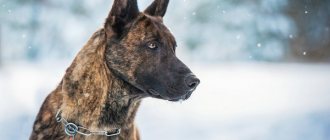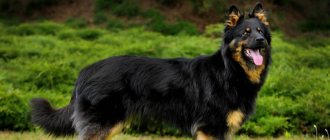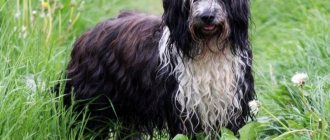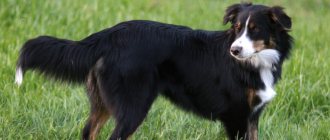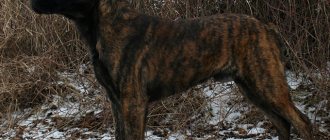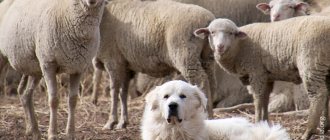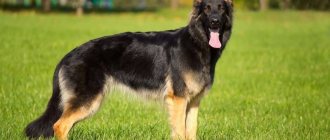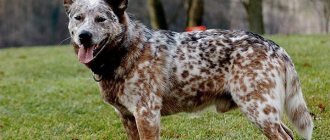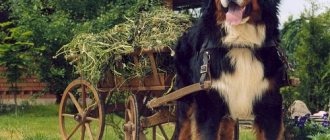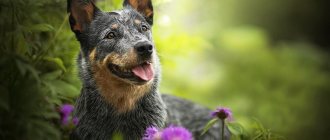Brief historical background
According to official data, the history of the breed goes back just over two hundred years. Although, it is possible that dogs similar to Herderhunders appeared in Holland earlier. Their ancestors are considered to be Belgian shepherd dogs (Malinois), who crossed the border between two neighboring states with flocks of sheep and crossed over the centuries with local dogs.
Herderhunder literally means “shepherd”. Dogs were bred by people of the same profession, focusing primarily on working qualities and not paying any attention to exterior characteristics.
Clubs for fans of this breed in the Netherlands began to appear after 1860. For the first time, Dutch herding dogs were presented in 1874 at the Amsterdam exhibition under the simple name “local shepherd dogs”. They received their breed name Hollandse Herdershond in 1878, and on June 12, 1898 (the official birthday of the breed), the national Dutch Shepherd Club was founded, in whose stud book 17 individuals were immediately entered. However, a preliminary standard was not described until 1935.
The Dutch Shepherd standard is considered one of the oldest, and it has only changed twice.
The Dutch Shepherd is considered a national treasure of the Netherlands.
The international canine community recognized the breed in 1960, at which time the standard requirements were refined and changed. In the FCI registry, Dutch Shepherds are listed under number 223 (1st group - “Shepherd and Cattle Dogs”, 1st section - “Shepherd Dogs”) . The current current standard dates back to October 21, 2009.
The first pair of Dutch Shepherds were brought to Russia from the United States in the early 2000s, and the first litter was registered only in 2013.
Mating
A dog is bred for the first time no earlier than 24 months. The meeting always takes place on the male's territory. Considering the low prevalence of the breed in the world, you will most likely have to look for a partner in another country.
There are Herder breeders in the Netherlands, France, Belgium, and the USA, so the owner will have to spend money on tickets and accommodation for himself and his pet.
A pair is selected based on exhibition prospects, as well as the possibility of improving breed characteristics. After the first meeting, you need to repeat the mating 2-3 more times with an interval of a day .
Read a detailed article on the topic: “Everything you need to know about breeding dogs: appropriate age, what to do if it doesn’t work out, rules and tips.”
Character of the breed
Netherland Shepherds are distinguished by their light, active character, but at the same time they have a balanced and calm temperament . They literally cannot sit still, trying to quickly fulfill the instructions of their adored owner, to whom they are attached with all their hearts. Dogs are able to take initiative and make independent decisions. Alert and sensitive, the Dutch are good watchmen and bodyguards, harmoniously combining fearlessness with intelligence and intelligence.
Lack of attention, prolonged loneliness and lack of close connection with people are difficult for the breed. The pet treats strangers with distrust, is not afraid, but also rarely shows aggression. The dog will never even bark in vain; he only voices when necessary. The Dutch adapt well to various situations and easily get used to any conditions.
Dutch Shepherds always vigilantly guard the territory entrusted to them.
It has been observed that Dutch Shepherds are hostile to strangers only when they try to enter the house. Dogs are completely indifferent to strangers outside the protected area.
Sociable and friendly shepherds can work with several dogs, for example, when herding sheep. They behave peacefully with other pets, keeping them under their protection and constantly trying to gather everyone in one place. Children are treated kindly and tenderly, happily keeping company in all kinds of outdoor games and childish pranks. Patient animals protect and protect babies.
Interesting Facts
The Dutch Shepherd is clear proof that any breed can have many amazing stories to tell:
- The alternative name of the breed, Herder, has Dutch roots and means “shepherd, cattle breeder.”
- Initially, Dutch Shepherds specialized in herding livestock. Now Herders are actively involved in the army, police and security structures. Dogs are also used as guide dogs and pets.
- The Dutch Shepherd is a rare breed, not very common outside its historical homeland. Most of the Herder population lives in the Netherlands, Belgium, and Switzerland.
How to choose a brindle shepherd puppy
Buying a Dutch Shepherd is very difficult, since no more than three hundred puppies are registered in the world every year, and most of them are in their historical homeland. It is recommended to purchase an animal only from trusted nurseries that have a large number of positive reviews and a good reputation. A responsible and conscientious breeder provides the necessary set of documents confirming the puppy’s pedigree (parents’ pedigrees, puppy statistics, etc.).
Dutch Shepherds are born almost black, only after two months does the characteristic brindle appearance of the breed begin to appear. Even the type of coat cannot be predicted immediately.
average cost
In European nurseries, the cost of purebred Dutch Shepherds varies from 500 to 700 euros. In our country, these dogs can be bought for 35–60 thousand rubles. The specific amount directly depends on the title of the parents, pedigree, color and type of coat.
It is impossible to find a purebred Dutch Shepherd from an advertisement or from someone else. In such cases, they usually offer a puppy that is visually very similar. Before purchasing, it is best to seek help from an experienced dog handler who understands the nuances of this particular breed.
Dutch Shepherd puppies are born almost black, then gradually acquire the breed's brindle color.
Distinctive features
Herderhunders, according to the established FCI standards, must meet the following requirements:
- The head is slightly elongated, wedge-shaped, dry, the skull is flattened, the stop is not clearly defined.
- The nose is exclusively black.
- The lips fit tightly, slightly covering the lower jaw.
- Bite – scissors, 42 teeth included.
- The eyes are almond-shaped, not very large, and located at a distance from each other. The color is deep brown, with a black outline.
- The neck is of medium length, dry, with a smooth transition to the shoulder blades.
- The ears are triangle-shaped, long, and set high. Rounded or crooked ones are considered defective.
- The tail is longer than average, straight or slightly curved.
- The body is light, lean, the spine and lower back are straight. The length is slightly greater than the height. The sternum is narrow but deep.
- The legs are muscular, light, moderately angulated. The paw pads are dark, the nails are only black.
Wool can be of 3 types:
- Long (rare variety). Approximately the same expression throughout the body (except for the muzzle, paws, ears, surface below the hock joint on the hind legs), rough. The color is brindle or pure black (gray hair and silver tint are acceptable).
- Tough . The hair is very densely packed, close, looks disheveled, with a good undercoat. The mustache, beard, eyebrows are clearly visible on the face, and the “pants” on the hind legs are pronounced. Color brindle, pepper and salt, gray-blue.
- Short (most common). The hair is hard, with a dense undercoat, the “collar” and “pants” are pronounced, the tail is heavily pubescent. Tiger color.
Keeping a Dutch (Dutch) Shepherd
The Sheepdog, being a peasant shepherd dog, needs space and freedom of movement. She will feel most comfortable in a country or private house, where she can walk and run in a large courtyard or enclosure (you need to equip an insulated booth there).
Netherland Shepherds cannot be chained or locked up.
Representatives of the breed are able to adapt to cramped living conditions, but can sometimes be destructive due to excessive activity and mobility.
Social qualities
Due to its natural endurance, the Georgian mountain dog has increased performance. She is not afraid of low temperatures and high loads. The Georgian Mountain Dog is suspicious of strangers. The pet looks calm and slow, but makes decisions quickly and reacts with lightning speed to any circumstances. Nagazi is able to assess the level of danger and is instinctively disposed to protect those who are weaker. Based on these characteristics, the breed can be defined as suitable for guard duty.
The Georgian Shepherd is a leader by nature. In the family where she grew up, she does not show aggression, but her wayward character requires a strong-willed owner. Nagazi obeys only one person unquestioningly; the rest will have to negotiate with her.
Nagazi easily finds a common language with children. The dog is able to distinguish small ones from adults. She enjoys participating in children’s games and clearly controls her strength. Tolerant of the pranks of children, tends to patronize those who are weaker.
The Georgian Shepherd gets along with other pets, including cats and birds. The breed was bred to guard herds, so there is no aggression towards animals in it. With dogs, regardless of breed, leadership disputes can arise. This is a temporary phenomenon that goes away as soon as the relationship between the animals is clarified.
Features of care
There are no difficulties in caring for Dutch Shepherds.
Hygiene
A standard set of hygiene procedures:
- Brush weekly with a strong brush; during active shedding, this should be done daily. Wire-haired varieties should be trimmed once every six months.
- Once every 5-7 days, inspect the ears and eyes, clean with cotton pads with zoo lotion.
- Brush your teeth every 7-10 days using animal paste and a special brush.
- Trim the nails, if they do not grind down on their own, about once a month.
- Bath as little as possible, only when absolutely necessary (no more than once a year).
Walk
Dutch Shepherds must have the opportunity to run and play to their heart's content, otherwise their character will deteriorate. You need to walk these dogs twice a day for 1.5–2 hours, and not just walk, but give the pet the opportunity to play, jump, run and perform various physical exercises (for example, on a dog playground).
The breed is suitable for active and restless owners who can provide their pets with the proper level of physical activity, taking them with them for a morning jog in the park, bike rides, trips out of town, etc.
You need to walk with shepherds a lot and for a long time
Nutrition
When it comes to food, Dutch Shepherds are completely unpretentious. They can be fed with both factory-made freeze-dried food, choosing products of at least super premium class (Pro Plan Adult Large Athletic, Royal Canin HE Club, etc.), and home-made freshly prepared food. Adult dogs are given food twice a day, puppies more often - 3-6 times a day.
The natural diet consists of:
- lean raw meat (horse meat, rabbit, veal, etc.);
- offal and meat trimmings;
- cereals (rice, buckwheat, etc.);
- eggs;
- fermented milk products with reduced fat content (cottage cheese, fermented baked milk, kefir, etc.);
- unrefined vegetable oils;
- greens, seasonal fruits and vegetables;
- ocean fish (boiled, boneless);
- vitamin and mineral complexes.
It is forbidden to feed shepherds fatty, sweet, smoked, fried, as well as citrus fruits, legumes and tubular bones.
Flaws
Disadvantages include physical and mental deviations from the standard; if they do not affect the quality of life, then the pet will live a long and happy life, but without participation in exhibitions and access to breeding.
The most common of them:
- Lack of uniform color, presence of white spots in large quantities;
- Preventing the testicles from entering the scrotum in male dogs;
- Lack of correct bite, misalignment of the jaw, lack of a full set of teeth or fangs, crooked front teeth;
- Unpainted eyelids, nose or lips;
- Insufficient color of the iris;
- Too large or small bone;
- Distortion of the lower back, shoulder, back;
- Short back, neck, lower back;
- Insufficiently developed muscles, low weight;
- Slanted croup;
- Too wide and large head;
- Light cartilage, recumbent ears;
- Mental disorders - cowardice, aggression;
- Tail crease;
- Round chest;
- Neck too long;
- Different eye colors;
- No black mask;
- Scanty wool.
Training and education
Incredibly flexible and attentive, Dutch Shepherds are very easy to train. Dogs learn quickly, grasping everything on the fly and instantly remembering commands.
The puppy needs to be introduced to the rules of behavior and socialized from a very early age, otherwise he may grow up to be fearful and unsociable. When training, it is extremely important to act confidently, consistently and patiently, as independent Shepherds tend to be stubborn. The owner must be a leader and authority for the dog.
Dutch Shepherds are highly trainable and participate in various dog competitions.
When working with Dutch women, cruelty and physical punishment are excluded.
Application
The Dutch Herder breed has exceptional herding qualities, which it received from its historical ancestors. For 200 years, the selection of dogs for breeding was carried out according to performance parameters, which gave good results. Among all related breeds, Dutch Shepherds are considered the best herders of farm animals.
Now the need for herding dogs has decreased significantly, and Herders have changed their main purpose. The Danish Shepherd not only serves as a faithful companion, but also performs duties as:
- watchman;
- rescuer;
- guide;
- athlete.
The Dutch Shepherd long-haired, short-haired and wire-haired have no differences in character and behavior. Animals are well trained in commands, which, with the strong authority of the owner and developed intelligence, makes it possible to perform job duties efficiently. Attentiveness, good hearing, and keen eyesight make the Herder an excellent guard.
Constant training and exercise are the key to high results in sports competitions. A purposeful Dutch Shepherd knows how to concentrate on a task and is not distracted by other dogs or people.
The best nicknames for representatives of the breed
The unusual, albeit rustic appearance of Dutch Shepherds suggests equally interesting names.
The following nicknames are suitable for boys:
- Dirk;
- Patrick;
- Mayer;
- Johan;
- Gray.
Girls can be called like this:
- Cutie;
- Odette;
- Icy;
- Iris;
- Hel.
Pedigree puppies are given nicknames at the club. For example, when our German Drahthaar dog had puppies, they were all given names starting with the letter “O”. These official nicknames were recorded in the puppy's records, and the new owners called them whatever they wanted.
Diseases
The Dutch Shepherd does not have any serious hereditary diseases. A common problem for Herders is hip dysplasia. To avoid this disease in your pet, it is important to request pictures of the litter's parents. As a rule, large breeders and nurseries do them before planned mating.
With illiterate care and maintenance, there is a risk of bedsores and alopecia. In old age, dogs often experience decreased vision and develop cataracts or blindness. The lifespan of a shepherd dog can be up to 15 years. Like other breeds, puppies require routine vaccinations starting at 2 months.
Unofficial type of Dutch X
In its homeland in the Netherlands, there is an unofficial type of shepherd dog, the ancestor of which was service animals, without a pedigree. All representatives were bred solely for reasons of improving the working qualities of the dog, a sufficient amount of different blood has accumulated in them, they are officially recognized as a crossbreed.
Possessing ideal performance characteristics gives them the opportunity to exist without recognition by pedigree.
Appearance of Bernese Mountain Dogs
Bernese Mountain Dog puppy at 6 weeks
Bernese Shepherds are fairly large dogs with long black and fawn hair and white spots on the nose, neck and paws. The breed is considered to be the so-called “smile” Bernese. In a calm state, the muscles of the dog’s muzzle and head relax, opening its mouth slightly and creating the illusion of human facial expressions. The reference height at the withers for males is from 64 to 70 cm, for females - from 58 to 67 cm. The average weight of the Bernese Mountain Dog ranges from 39-50 kg for males, 38-48 kg for females.
Head
Proportional, large. The skull is massive, rounded, which is especially noticeable when looking at the animal in profile. The frontal groove is not clearly expressed. The transition from the frontal part to the muzzle is smooth, without sharp lines. The nose is large, black, with large nostrils.
Jaws and teeth
The standard bite is a scissor bite, but in some cases a pincer (straight) option is also acceptable. The teeth of the Bernese Mountain Dog are large, strong, and located in one line.
Eyes
The eyes are medium-sized, almond-shaped, set straight. The shade of the iris is dark brown, the whites of the eyes are not noticeable. The eyelids are dry and black (“damp” eyelids are considered defects).
Ears
Medium size, regular triangular shape, set high. At rest, pendulous, the tip of the ear is slightly rounded. When the Bernese Mountain Dog is alert, the front of the ear continues to remain flat against the skull, while the back of the ear is raised slightly.
Medium length, muscular, with a prominent scruff and well-developed withers.
Bernese Mountain Dog muzzle
Body
The body is compact, strong, with a wide, straight back and a deep, long chest. The ribs are convex. The loin is short, slightly narrower than the chest and croup.
Limbs
The Bernese Mountain Dog's forelimbs are straight, even, and set wide apart. The shoulder blades are elongated, tilted back. The humeroscapular angle is usually 100°. The hind legs are straight, strong, and muscular. The thighs are elongated, with developed muscles. The hock joints are strong, with a pronounced angle. Dewclaws (rudimentary finger-like processes located above the paws of the hind legs) in purebred individuals must be removed. The paws are directed forward, rounded, with elastic pads. The hind legs are collected into a less prominent “lump” than the front legs.
Tail
The tail of the Bernese Mountain Dog is massive, saber-shaped, tapering from the base towards the end. In a calm animal it is lowered, in an excited animal it rises to the level of the back and higher.
Color
The predominant body color of the Mountain Dog is black. Areas of rich fawn coat are located on the chest, all four legs and above the eyes. White markings in Bernese Shepherds can be on the head in the form of a groove (should not reach the fawn areas of the coat), on the muzzle in the form of a spot (should not extend beyond the corners of the mouth) and chest. White “socks” on the paws and a white tip of the tail are also considered ideal parameters. The presence of small white “fragments” in the back of the head and anus is acceptable.
Major vices
Bernese Mountain Dog paw
Bernese Mountain Dogs may have deviations from the breed standard:
- too light frame;
- incorrect placement of incisors with correct bite;
- curly wool;
- the absence of white “flaps” on the head, as well as their excess quantity;
- black body color with a pronounced brown or red undertone;
- color asymmetry;
- the white areas of the coat have a grayish tint.
To disqualify a show class animal, the following defects are sufficient:
- progenia (overshot) or undershot;
- entropy (inversion of the eyelid);
- creases in the tail, or a tail curled into a donut;
- split nose;
- short coat, or the so-called “double coat” (when the undercoat “eclipses” the guard hair);
- aggression or cowardice of the animal;
- cryptorchidism;
- insufficient growth.
What diseases are Herders prone to, and how long do they live?
The Dutch are extremely healthy dogs. They are not characterized by specific diseases from which other types of shepherd dogs suffer (epilepsy, joint dysplasia, tympanitis, etc.).
The first health difficulties begin in Herders at the age of 10 (with a total life expectancy of 16 years, this is very old age). Such ailments are mostly degenerative in nature and have nothing to do with the dog’s heredity. Thus, the gradual wear and tear of a shepherd’s body most often leads to:
- problems in the cardiovascular system;
- lameness resulting from damage to the articular apparatus or the death of part of the nerve endings involved in the movement of the paws;
- development of cancerous tumors;
- endometritis (inflammation of the uterus) in unsterilized, breeding bitches.
Appearance
The Istrian Hound is a strong, strong, medium-sized dog with well-developed bones and muscles, snow-white in color with lemon-orange spots. The length of the body exceeds the height by approximately 10%. Sexual dimorphism is pronounced.
- Height at withers - 46-58 cm;
- Weight - 16-24 kg.
Each variety of Istrian hound has its own Standard (No. 151 and No. 152), but the descriptions and requirements in them are almost identical. The exception is the item on coat.
The head is harmonious, 20-24 cm long, without folds or wrinkles. The muzzle is long, wide at the base, tapering towards the nose. The bridge of the nose is straight. The lobe is black or dark brown. The teeth are strong, scissor bite. The eyes are oval in shape, the eyelids are dark. The ears are thin, set slightly above eye level, tapering to the tips, elongated reaching the fangs. The neck is slightly curved, approximately 15-20 cm long.
The case is of a moderately stretched format. The topline falls towards the croup. The back is straight. The loin is short and wide. The croup is long. The chest is deep and wide. The chest circumference is 12-15 cm greater than the height. The abdomen is slightly tucked. The tail is saber-shaped, set high. Limbs with well-developed muscles and bones, strong. The paws are cat-like, with elastic pads and strong claws.
The skin is elastic, pink. Wool:
- Smooth-haired dogs have a dense, fine, glossy coat. Sometimes a little longer on the back of the thighs and underside of the tail, but this is not desirable.
- In wire-haired dogs, they are 5-10 cm long, bristly, matte. Does not fit tightly to the body, sticks out. The undercoat is short and dense. The length and thickness of the outer hair varies in different parts of the body.
The color is snow-white with orange spots, which are usually located on the ears, under the tail and on the body. Speckling on the body is allowed.
